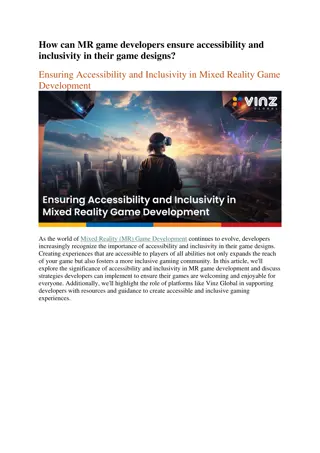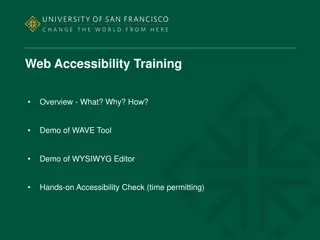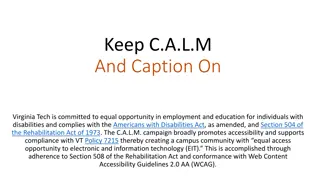Promoting Inclusivity and Accessibility in Independent Living Research Utilization
This content highlights the importance of creating a welcoming and supportive environment for diverse populations in independent living research and utilization. It emphasizes inclusive practices such as gender-neutral bathrooms, welcoming messages, and displays of diversity. The text also discusses the significance of staff training, accessible facilities, and programs tailored to different groups to foster a sense of value for all individuals.
Download Presentation

Please find below an Image/Link to download the presentation.
The content on the website is provided AS IS for your information and personal use only. It may not be sold, licensed, or shared on other websites without obtaining consent from the author.If you encounter any issues during the download, it is possible that the publisher has removed the file from their server.
You are allowed to download the files provided on this website for personal or commercial use, subject to the condition that they are used lawfully. All files are the property of their respective owners.
The content on the website is provided AS IS for your information and personal use only. It may not be sold, licensed, or shared on other websites without obtaining consent from the author.
E N D
Presentation Transcript
Independent Living Research Utilization Independent Living Research Utilization 1
Creating a Welcoming and Supportive CIL Creating a Welcoming and Supportive CIL for Diverse Populations for Diverse Populations Kim Gibson and Liz Sherwin Kim Gibson and Liz Sherwin 3
Kim Gibson Kim Gibson disABILITY disABILITY LINK LINK 4
disABILITY LINK Welcoming Environment disABILITY LINK Welcoming Environment Voice message at door welcoming to office. Gender neutral bathrooms (labeled as such). Messages at front door/window such as Black Lives Matter, Women s Rights are Human Rights, Love is Love (welcoming and inclusive message even before opening the door!) Pictures, posters, photos, flags, art, messages displayed that reflect all types of diversity including race, income, religion, age, sexual preferences to convey a message that help all people feel at home. Also women s rights, worker s rights, Native American rights, veteran s rights, immigrant rights, electoral rights, LGBTQIA+++ rights, civil rights, religious/spiritual freedom, environmental rights. 5
Environment from the Door to the Environment from the Door to the Staff to the Office Staff to the Office Door greeter welcoming individuals. Training of staff. Signage on door. Reached out to local authority to place a cross light for individuals. Message board with iPod for anything posted for individuals to hear Large print available. All areas are kept accessible including desks. Computers for public use have adjustable tables and programs for accessibility such as Jaws. Scent-free materials used. Greeter at desk to invite people in and assist to different locations. Often staffed with volunteers or interns. 6
Create a Feeling of Value of All Create a Feeling of Value of All disABILITY LINK disABILITY LINK Learning Experiences Programs set for different groups to learn such as Tech Tuesday for all. Tech Wednesday focuses on the deaf population. Providing materials in different format. Zoom technology allows for captioning. Use of microphone at all events. Engagement with the consumer, staff, board and community Asking all what is their interest. Peer support classes often led by board members Hearing Voices Network led by board member, Respect Institute. 7
Equipment and Materials Equipment and Materials disABILITY LINK disABILITY LINK Using visuals to convey the messages. Using different communications devices UbiDuo communications software Provides communication equality between people who are deaf, hard of hearing, and hearing. On demand interpreters for different languages. Kept at front desk for anyone to sign out and use. Most useful to have on hand right from the start. 8
Special Considerations Special Considerations disABILITY LINK disABILITY LINK Are we representing the groups that are in our service area? Regular self-assessments Pre and post surveys Online feedback forms Outcome surveys Listening to the staff and consumers. Being pro-active rather than reactive. Adjusting to what works and making changes. 9
Community Engagement Community Engagement disABILITY LINK Participation in social justice events. MLK Parade Pride Parade Collaborations with different groups. Black Lives Matter NAACP Latino, Korean, Muslim, Jewish, etc. LGBTQIAP Reaching out to meet the needs of rural populations. Community outreach and participation using health fairs, support groups, VR, Senior Centers, Churches, international days, etc. Use of partnerships for meeting spaces. disABILITY LINK 10
Technology for Rural Outreach Technology for Rural Outreach disABILITY disABILITY LINK LINK Zoom technology Video conferencing that can be accessed on any phone/computer. Does not necessarily have to have video. Use for all classes Sign-in sheet lists that it is being used and we state this at the beginning of all classes. Allows for individuals to participate and feel part of the group. Has captioning ability. 11
Technology for Rural Outreach Technology for Rural Outreach disABILITY disABILITY LINK, LINK, cont d. Other Technology Use of Access interpreting that allows for on- demand interpreting as well as scheduled interpreting. All staff trained and can be accessed on computer, phone, iPad. Use of LanguageLine for a variety of languages. https://www.languageline.com/interpreting/phone Use of peer supporters. cont d. 12
Hiring, Recruiting, and Supporting Hiring, Recruiting, and Supporting Staff and Board Staff and Board disABILITY LINK disABILITY LINK Hiring of staff reflective of the community. Recruitment of board reflective of community. Community assessment. Requires changing policies to reflect diversity. Supporting staff and board through training. Weekly trainings held. Peer support for all new employees (curriculum addresses issues of diversity in peer support). Board training required before being considered to be on the board. 13
Supporting Staff and Board Supporting Staff and Board Commitment to DDI Commitment to DDI disABILITY Cultural diversity training provided: In our peer support trainings. In staff meetings. Workshop presentations. Outreach into the communities. Creating partnerships and passion from staff. Having staff taking ownership of programs. Staff are empowered to bring ideas and then develop the classes within that perspective. Workshop proposals sheets are completed. disABILITY LINK LINK 14
Supporting Staff and Board Commitment Supporting Staff and Board Commitment to DDI to DDI cont d. cont d. Creating a culture within a culture. Taking inventory of where you are and where you want to be: Developing a Strategic Plan. Looking at our annual reports and comparing to our population. Encouraging staff to bring forth ideas and address individual needs and goals they are passionate about. Commitment to support consumers from unique perspectives. Collaborating and using peer supporters to reach out to different groups. 15
Creating a Welcoming and Supportive CIL Creating a Welcoming and Supportive CIL for Diverse Populations for Diverse Populations Liz Sherwin Liz Sherwin IICIL IICIL 16
The community that you serve has to feel that you The community that you serve has to feel that you are a part of them .People know me, see me, and are a part of them .People know me, see me, and trust me. It s the same with the rest of the staff. trust me. It s the same with the rest of the staff. Those are the kinds of things that validate us Those are the kinds of things that validate us because we are part of the community and that s because we are part of the community and that s how we are able to provide that level of service. how we are able to provide that level of service. ~ Liz Sherwin, Executive Director ~ Liz Sherwin, Executive Director Illinois Iowa Center for Independent Living (Illinois/Iowa) Illinois Iowa Center for Independent Living (Illinois/Iowa) 17 17
Acknowledging What Is Different in Rural Acknowledging What Is Different in Rural Areas Areas What is often different in rural areas are Higher rates of disability. The logistics, distances to negotiate. Fragmented healthcare delivery system. Stretched and diminishing rural workforce. Certain target populations (e.g. farm workers). Fewer or no resources and options of all kinds. rural people with disabilities participate in their communities less and have few opportunities to take advantage of community resources, even at the smallest scale (Sage, Myers, & Ravesloot, 2017). 18
Identifying Populations Identifying Populations Unrepresented and Underrepresented Unrepresented and Underrepresented Know the demographics of your service area Age Gender Racial and Ethnic background Disability Residential status Socioeconomic status Urban vs. Rural Religion/Faith Groups Sexual Orientation 19
Potential Sources for Finding Potential Sources for Finding Information Information Census Bureau CIL PPR/704 Report demographic page Bureau of Vital Statistics Chamber of Commerce City and County Planning Departments Community Action Centers Local College and University libraries United Way Public Housing Authorities Urban Leagues NAACP Others 20
Get Information Get Information National National Local Sources: Telephone & Service Directories Libraries Community Colleges & Universities City and County Planning Local Ethnic & Service Orgs State Sources: Rehabilitation Services Statewide Independent Living Councils Assistive Technology Projects Disability/Advocacy Councils & Orgs Local, State, and Local, State, and National Sources: Independent Living Research Utilization Association of Programs for Rural Independent Living National Council on Independent Living Census Bureau www.census.gov National Council on Disability National Organization on Disability 21
What Organizations, Programs, and What Organizations, Programs, and Services are Already Available? Services are Already Available? Do they promote the independent living philosophy? Are people satisfied? Why/why not? What are the key issues to address? How do you know what they are? 22
Who is not being served and why? Who is not being served and why? What are the barriers? What local organizations might support CIL activities? How do we demonstrate community support for those needs? How can CILs adjust their programs to meet those needs? Examples of effective outreach successes. 23
Know and Respect Cultural Differences Know and Respect Cultural Differences Not all cultures understand or accept the IL philosophy. One cannot make assumptions about groups. Collect information in a way that is open. Respect cultural language, traditions, beliefs and spiritual perspective of the target population. Consider the social and economic climate. Do not stereotype cultures. Know the issues and priorities. Know the leaders and key players. 24
Know Your Communities Know Your Communities 1. Identify bilingual and bicultural partners. 2. Gather reliable information: Conduct focus groups. Conduct interviews. Conduct mail or telephone surveys. Assess CIL information and referral data. 3. Develop a list of issues or information. 4. Use target group to train staff and board. 25
Build Partnerships Build Partnerships Work with organizations that serve targeted populations. (examples: MLK Community Center ACTIVE Club; Rock Island NAACP) Understand their programs. Make sure CIL services are complementary. Recruit board and staff that reflect community. Assure board and staff are community leaders. 26
Marketing and Public Relations Marketing and Public Relations Incorporate community issues into your Strategic Plan. (examples; NPC 11 Clean-up; NAACP Expungement Workshops) Develop a public relations campaign. Create outreach materials targeting needs of specific groups. 27
Accessible Materials to All Accessible Materials to All Write at a reading level that is easy to understand. Avoid acronyms and professional phrases that are not easily understood. Use language that can be understood. Accessible in a variety of formats: Braille, large print, tape and disk. Qualified persons should edit and proof. 28
Monitor the Effectiveness of your Monitor the Effectiveness of your Public Relations Public Relations Get feedback. Make staff available to communicate. Develop process to address language and cultural issues. 29
Getting Information Out Getting Information Out Train Board and staff Program Strategy Team. Designate a lead person. Maintain current list of media contacts. Develop relationships with local media. Respond to issues in editorials and opinion pages. Create a media package. Build a public and community history. Information should be accurate and cost- effective. 30
Enhancing Your Public Relation Enhancing Your Public Relation Strategies Strategies Create opportunities through radio, TV, and newspapers on a regular basis. Utilize existing mailings. Develop partnerships (local college interns). Respond to hot issues. 31
Create Opportunities Create Opportunities Regular information magazines. Public television programs. Column in a local newspaper or newsletter. Use your own calendars and newsletters. 32
Getting the Word Getting the Word Out Out Network with other agencies. Provide website updates and e-alerts. Produce disability issues program on public TV or radio. Locate good, generic videos. Write a grant to produce a video. Expand partnerships by getting consumers on Boards and Commissions. Set up videoconferences with others. Use list serves and group emails. Contact an advertising club for donated time. 33
Implementation and Evaluation Implementation and Evaluation Implement an outreach action plan. Target a specific group or community. Assign a team with a leader. Collect and review information about the group. Develop a timeline. Develop a budget if needed. Implement. Example: Identify a community or group (Don t bite off more than you can chew!) 34
Evaluating Outreach Effectiveness Evaluating Outreach Effectiveness Formative Evaluation. Series of activities to improve outreach. Have an expert review and comment on your plan. Make changes in the plan based on new data. Try a small scale outreach effort. Revise according to feedback. 35
Process Evaluation Process Evaluation How successful was the outreach design? Takes place during and after implementation. Gather an outreach evaluation (one page). Make changes based on feedback and interviews. 36
Outcome Evaluation Outcome Evaluation Measure the impact and people who have benefited. Review data collected in the Program Performance Reports (PPRs). Calculate a cost benefit analysis. Evaluate success based on satisfaction level of new persons reached. 37
Analysis Analysis Who do we provide outreach to? What do we know about the population? Where do we start implementing it? When should this process be started/completed? How will we evaluate or know if we succeeded? When completed: What outcomes will be measured? What are the cost benefits? What is the satisfaction level of consumers? 38
Contact Contact Kim Gibson Kgibson@disabilitylink.org Liz Sherwin liz@iicil.com 39
Small Group Activity Small Group Activity QUESTION to discuss at your table: What can you do at your center to create a welcoming and supportive CIL for diverse populations? 40
CIL CIL- -NET Attribution NET Attribution This project is supported by grant number 90ILTA0001 from the U.S. Administration for Community Living, Department of Health and Human Services, Washington, D.C. 20201. Grantees undertaking projects under government sponsorship are encouraged to express freely their findings and conclusions. Points of view or opinions do not, therefore, necessarily represent official Administration for Community Living policy. 41























